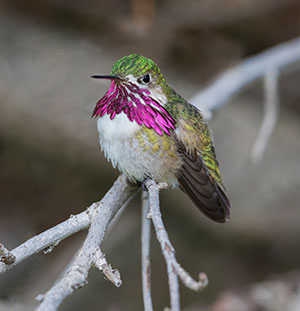
Hummingbirds are small but remarkably tough. Some species make migrations of more than 5,590 miles a year. Their journeys are largely fueled by nectar, which is sipped from wildflowers and converted to fat.
However, climate and land-use change are making the distribution of wildflowers along their migratory routes more unpredictable. To buffer against these challenges, hummingbirds use a process called torpor, a sort of overnight hibernation.
Researchers from the University of Wyoming and the University of New Mexico investigated how hummingbirds use torpor during migration in a paper published this month in Proceedings of The Royal Society B, a biological research journal.
Shayne Halter, a doctoral candidate in the Department of Biology at the University of New Mexico, is the co-author of a paper titled “The hummingbird’s adipostat: can a simple rule explain torpor frequency and duration in hummingbirds?” with Carlos Martinez del Rio, a professor emeritus in the UW Department of Zoology and Physiology.
Halter conducted the research along with Blair Wolf, a professor of biology at the University of New Mexico. Martinez del Rio helped Halter build mathematical models, analyze data and write the paper.
The researchers examined two species of migrating hummingbirds -- Calliope (Selasphorus calliope) and Rufous hummingbirds (Selasphorus rufus) -- at a site along the Mimbres River in New Mexico and measured how the birds’ temperatures changed overnight.
Torpor is characterized by a sharp decrease in metabolic rate and body temperature for several hours. Though torpor saves energy, hummingbirds are vulnerable to predators and other dangers during torpor, making it a risky strategy.
The researchers looked at overnight metabolic measurements and body fat and found that they could predict when hummingbirds would enter torpor and how long they would remain in a torpor state. They discovered that hummingbirds require a certain amount of fat in the morning to get them started toward their next meal. When maintaining a normal body temperature during the night would cause their morning fat reserves to fall below a critical value, hummingbirds entered torpor.
“I think it’s almost magical,” says Martinez del Rio. “Imagine if we could sense how much fat we have and suddenly drop our temperature to stay in a state of suspended animation. The length of our animation is dictated so that we come out of it with the amount of fat needed the next day.”
Due to the changing timing and distribution of nectar sources along their annual migration routes, migrating hummingbirds may become increasingly challenged to maintain adequate energy levels. By providing a model that predicts torpor frequencies, durations and fat reserves in migrating hummingbirds, this research will help determine the ecological health of hummingbirds; define their energetic thresholds and limits; and find ways to conserve these creatures.
“Conserving is important because hummingbirds pollinate many wild plants, including Wyoming’s state flower, the Indian paintbrush,” says Martinez del Rio. “They also are super interesting models that can inform issues that matter to human health ... Finally, we must conserve them and study them because they are beautiful and fascinating.”
About the UW College of Agriculture, Life Sciences and Natural Resources
The University of Wyoming College of Agriculture, Life Sciences and Natural Resources serves students and communities through innovative scholarship, research and outreach. Guided by the land-grant principles of discovery and experiential learning, the college facilitates meaningful educational opportunities in the classroom, laboratory and community. The college offers degrees in the departments of agricultural and applied economics, animal science, botany, ecosystem science and management, family and consumer sciences, molecular biology, plant sciences, veterinary sciences, and zoology and physiology. The college also offers degree programs in agricultural communications, microbiology, and ranch management and agricultural leadership.
For more information, go to www.uwyo.edu/uwag or call (307) 766-4133.

